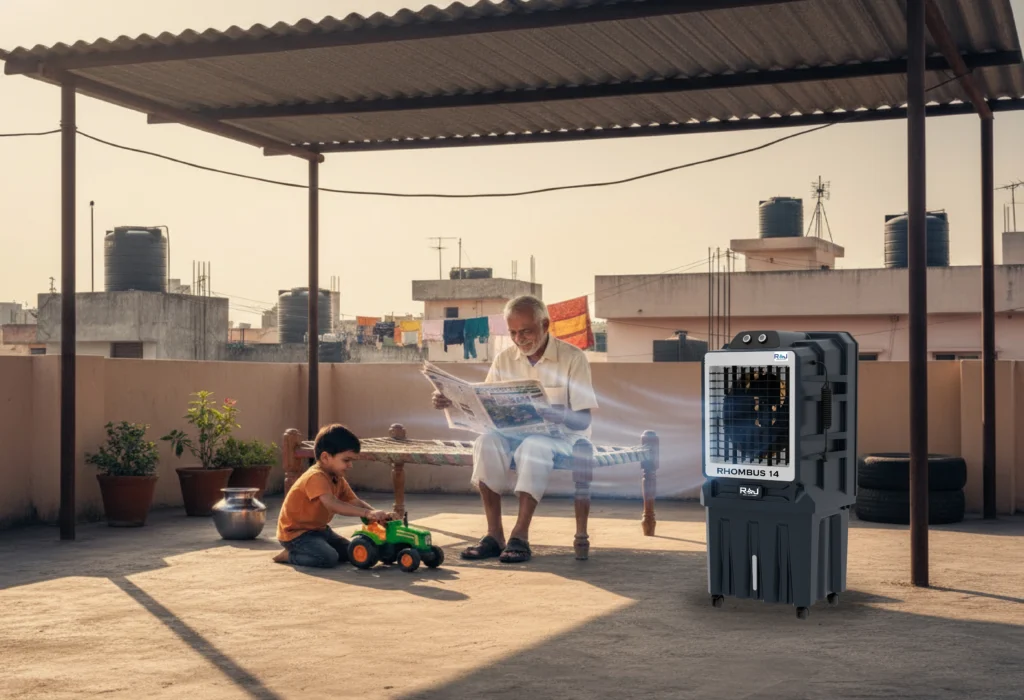India’s climate has been witnessing a steady rise in temperatures year after year, making reliable cooling solutions more of a necessity than a luxury. While metros have long embraced air conditioners, semi-urban and Tier 2–3 towns are seeing a different trend altogether, a surge in the popularity of air coolers. Driven by affordability, sustainability, and the country’s climatic suitability, air coolers have become the preferred choice for households, shops, and small-scale businesses looking for affordable cooling solutions.
This growing demand is not just about cost-effectiveness. it reflects a deeper awareness about eco-friendly cooling and energy savings. As India’s infrastructure and purchasing power evolve, semi-urban consumers are seeking smarter appliances that deliver performance, comfort, and value, and air coolers perfectly fit that balance.
Understanding the Semi-Urban Market
Semi-urban India, encompassing thousands of Tier 2 and Tier 3 towns, represents a vibrant segment of the country’s economy. These regions are characterized by rising middle-class income, expanding small enterprises, and improving infrastructure. Unlike urban centers where central air conditioning is common, semi-urban consumers value practicality, reliability, and low maintenance.
Climatic conditions play a huge role in shaping appliance choices. Most semi-urban areas in India experience dry or moderately humid weather, especially in northern, western, and central regions. The local climate allows evaporative coolers to perform efficiently while consuming minimal energy. Additionally, with improved access to electricity and stable voltage supply in smaller towns, families and businesses are increasingly upgrading from traditional ceiling fans to more effective and energy-efficient air coolers.
The rise of nuclear families, compact homes, and entrepreneurial workspaces such as salons, cafés, and offices has created a growing market for compact, portable, and efficient cooling solutions. Air coolers meet these needs beautifully, providing mobility, fresh air circulation, and comfort without recurring expenses.
Affordability and Accessibility
One of the biggest reasons behind the surge in air cooler popularity is their unmatched affordability. Compared to air conditioners, which involve higher initial costs, installation charges, and electricity bills, air coolers are budget-friendly from day one. Even premium models with advanced features are priced far lower than entry-level split or window ACs.
Beyond purchase cost, operational expenses make a major difference. Air coolers consume up to 80% less power than air conditioners. This means lower electricity bills are a critical factor for middle-income families and small shop owners in semi-urban regions. Maintenance is equally simple: replacing cooling pads or cleaning filters costs only a fraction of what it takes to service an AC.
Accessibility has also improved significantly. With the growth of e-commerce platforms and local dealership networks, air coolers are now available in every corner of India. Companies like Raj Cooling Systems have built extensive dealer networks, ensuring the timely availability of spare parts, service, and support, making coolers not just affordable but also practical for long-term use.
Climate Compatibility
India’s diverse geography makes evaporative coolers a natural fit for a majority of regions, particularly semi-urban zones. The evaporative cooling process works best in dry or moderately humid conditions, where it can reduce ambient temperatures by several degrees while keeping the air fresh and comfortable.
In contrast, air conditioners rely on sealed environments to maintain cooling, often leading to stale air and dryness. Air coolers, on the other hand, function best with open windows or doors, making them ideal for semi-urban homes that prioritize ventilation. They continuously draw in fresh outdoor air, pass it through water-saturated pads, and release cool, humidified air indoors. This not only reduces heat but also prevents dryness, maintaining a natural comfort level that suits India’s climate.
Eco-Friendly and Energy-Efficient Cooling
Sustainability has become a key consideration in modern appliance choices, and air coolers perfectly align with eco-friendly living. Their operation is based on a simple natural process, water evaporation which eliminates the need for refrigerants or harmful chemicals used in air conditioners. This ensures zero carbon emissions during cooling.
From an energy perspective, air coolers consume a fraction of the electricity that ACs require, making them the most energy-efficient cooling devices for semi-urban households. This reduced power consumption not only lowers monthly bills but also eases pressure on local power grids, which can be unstable in rural or semi-urban areas.
Furthermore, modern air coolers use recyclable materials, BLDC energy-saving motors, and smart water distribution systems to minimize environmental impact. These features make them an essential part of India’s transition toward eco-friendly cooling technologies that combine comfort with conservation.
Growing Awareness and Modern Features
The image of air coolers as simple, old-fashioned devices has changed dramatically in recent years. Today’s coolers are smarter, sleeker, and more feature-packed than ever before. Manufacturers have introduced innovations like remote controls, digital panels, inverter compatibility, and even air purification features such as dust filters and mosquito nets.
These advancements have made air coolers more appealing to tech-savvy semi-urban consumers who desire modern features without high costs. Many models also include water-level indicators, automatic swing mechanisms, and durable castor wheels for portability.
Awareness campaigns, online reviews, and demonstration videos have further educated buyers about the long-term benefits of air coolers. As consumers become more informed, they are realizing that coolers offer not just cost savings but also better air circulation and healthier living conditions compared to sealed air-conditioned spaces.
Government Push and Electrification Growth
India’s rapid rural electrification drive and infrastructure development have been key enablers of the air cooler boom. Over the past decade, access to reliable electricity has expanded dramatically in semi-urban and rural regions, empowering millions of families to use electric appliances like air coolers.
The government’s focus on “Make in India” and local manufacturing has also encouraged domestic production of energy-efficient air coolers, creating products tailored for Indian climates and budgets. With electricity connections now reaching nearly every household, even small towns can enjoy consistent cooling without worrying about high consumption costs.
Additionally, subsidies on renewable energy and awareness around sustainable living have motivated people to choose eco-friendly cooling alternatives over power-hungry options. This combination of infrastructure growth and environmental awareness has positioned air coolers as the ideal choice for modern semi-urban living.
The Role of Indian Manufacturers
Indian manufacturers have played a decisive role in shaping the air cooler market. Companies like Raj Cooling Systems Pvt. Ltd., Symphony Limited, Bajaj Electricals, and Crompton Greaves have become industry leaders by understanding local needs and designing products suited to India’s diverse climate.
Raj Cooling Systems Pvt. Ltd. has built its reputation on innovation, quality, and reliability. The company produces a wide range of air coolers from domestic and tent models to industrial and commercial variants, combining durability with high performance. With a focus on recyclable materials, advanced airflow designs, and low-noise operations, Raj Cooling Systems stands at the forefront of India’s eco-friendly cooling revolution.
What sets Indian manufacturers apart is their focus on real-world practicality. Unlike some global brands that design for controlled urban conditions, companies like Raj Cooling Systems, Symphony, and Bajaj engineer coolers to perform efficiently in dusty, hot, and semi-humid environments. Their products cater to real Indian conditions while supporting dealers and small retailers through strong after-sales service and easy spare-part availability.
Conclusion
The rise in air cooler popularity across semi-urban India reflects a broader transformation a shift toward smarter, sustainable, and affordable living. Air coolers meet the precise needs of India’s evolving middle class: comfort without compromise, cooling without heavy electricity bills, and freshness without environmental harm.
With their compatibility to local climates, low maintenance, and new-age features, air coolers are redefining what comfort means for millions of families and businesses across the country. As India continues to urbanize and seek greener technologies, Raj Cooling Systems remains committed to leading this movement, delivering innovation, reliability, and comfort that truly enhance the quality of human life and make industrial growth easier.

